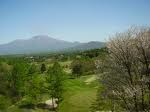:::::::::::::::::::::::::::::::::::::::::::::::::::::::::::::::::::::::::::::::::::::::::::::::::::::
Daruma Pilgrims Gallery
:::::::::::::::::::::::::::::::::::::::::::::::::::::::::::::::::::::::::::::::::::::::::::::::::::::
Karuizawa City and the Usui Pass
Karuizawa (軽井沢町, Karuizawa-machi)
is a town located in Kitasaku District, Nagano, Japan, overlooked by Mount Asama.
As of January 1, 2008, the town has an estimated population of 17,833 and has a total area of 156.05 square kilometres (60.25 sq mi).
Karuizawa is known throughout Japan as a popular tourist spot. People from Tokyo will travel to Karuizawa to get away from the city especially in summer. There is a Shinkansen station as well as a large outlet store shopping mall. It is also known for its historic shopping street known as "Ginza dōri" or "Kyū-dō" (Ginza Street, or the Old Road).
History
Edo Period:
Served as a post station town on Nakasendō, called Karuisawa-shuku at that time
1886: British theologian Alexander Croft Shaw introduced Karuizawa to fellow missionaries as a getaway spot, particularly as an escape from the summer heat of Tokyo
1910s: Begins to attract the attention of other expatriates and Japanese.
1922: Gained town status. The village of Higashinagakura becomes the town of Karuizawa
1951: Selected as International Cultural and Tourism City.
Karuisawa-shuku (軽井沢宿, Karuisawa-shuku)
was the eighteenth of the sixty-nine stations of the
Nakasendo 中仙道, the "Middle Road to Kyoto".

The place that was originally called Karuisawa is, in actuality, approximately two to three kilometers from the post town, which is located at the western entrance to the Usui Pass 薄井の峠.
Karuisawa-shuku flourished more than any other post town along the Nakasendō, with five honjin lodgings and sub-honjin, in addition to over 100 other structures for travelers.
During the Edo period, the post town also employed hundreds of meshimori onna (飯盛女), women who were employed by the Shōgun to serve food to travelers. To the east of the post town, a bridge crossed over the Yakazaki River, where travelers reluctantly parted with the meshimori onna.
From the Meiji period onwards, Karuisawa became a popular place with Western missionaries. It was at this point that the area's name changed from "Karuisawa" to the modern "Karuizawa," which is easier for foreigners to pronounce. Because there was a large number of foreigners in the area, many western-styled structures were also built up, which has resulted in few structures from the past remaining today.
© More in the WIKIPEDIA !
. . . CLICK here for Photos !
Nowadays, many haiku meetings (kukai 句会) are held in Karuizawa in summer, some in memoriam of Takahama Kyoshi.
http://www.kiraku.tv/category/10791/movie/1/YPPYmC2PCaQ
. Nakasendoo 中山道 The Nakasendo Road .
:::::::::::::::::::::::::::::::::::::::::::::::::::::::::::::::::::::::::::::::::::::::::::::::::::::

. Mount Asama 浅間山 and Haiku
:::::::::::::::::::::::::::::::::::::::::::::::::::::::::::::::::::::::::::::::::::::::::::::::::::::
On seeing a fellow traveller
馬をさへながむる雪のあした哉
uma o sae nagamuru yuki no ashita kana
a horse
to gaze upon on this
morning of snow . . .
18. Karuisawa-shuku 軽井沢宿
The cut marker KANA is at the end of line 3.
It has been a cold night with a lot of snow.
Some sources put this ku later, when Basho had reached Atsuta town.
Travelling the Nakasendo
. Matsuo Basho 松尾芭蕉 - Archives of the WKD .
:::::::::::::::::::::::::::::::::::::::::::::::::::::::::::::::::::::::::::::::::::::::::::::::::::::::
行雁の下るや恋の軽井沢
yuku kari no oriru ya koi no Karuizawa
traveling geese
go down to make love...
the town of Karuizawa
Issa, 1822
Shinji Ogawa explains that, in Issa's day, Karuizawa, close to the Mount Asama, "was a prosperous post town. Consequently, there might have been many prosititutes in the town. After the modern railroad passed it by, the town was forgotten for a while. However, an English missionary discovered the area as a good summer resort in 1886.
Now it is the most famous summer resort area in Japan."
Tr. David Lanoue
Kobayashi Issa
(June 15, 1763 - January 5, 1828)
:::::::::::::::::::::::::::::::::::::::::::::::::::::::::::::::::::::::::::::::::::::::::::::::::::::
夏木立花は薄井の峠かな
natsu kodachi hana wa Usui no Tooge kana
summer trees -
flowers at the pass
at Usui
Date Masamune 伊達政宗
(1567 - 1636)
A warlord and famous samurai
.................................................................................
Placenames PLACE NAMES used in Haiku
:::::::::::::::::::::::::::::::::::::::::::::::::::::::::::::::::::::::::::::::::::::::::::::::::::::
Daruma Pilgrims in Japan
[ . BACK to WORLDKIGO . TOP . ]
:::::::::::::::::::::::::::::::::::::::::::::::::::::::::::::::::::::::::::::::::::::::::::::::::::::






2 comments:
Kobayashi Issa
on the pass two days --
牛の汗あらし木がらし吹にけり
ushi no ase arashi kogarashi fuki ni keri
high winds
cold gusts stripping
sweat off cows
Tr. Chris Drake
This hokku was written by Issa as he made his way over high Usui Pass on the eastern border of his mountainous home province of Shinano at the end of the 10th month (November) in 1807.
MORE
EDO
meshimori onna 飯盛女 "woman serving rice"
They worked a the tea stalls along the main traveller's roads and sold not only food . . .
Post a Comment